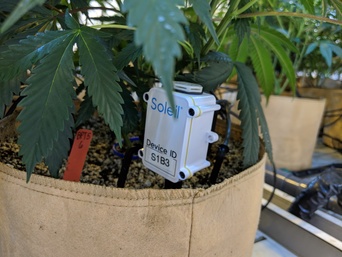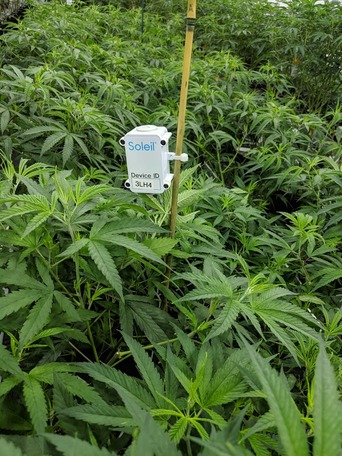We’ve all likely had the feeling of anxiety or at least intrigue at what goes on when it’s dark. Walking down a country, gravel road in the darkness of night should cause some unsettling sensations, especially when you hear the snorts of menacing nocturnal fauna which may or may not be deer. Or, if you’re like me, and are currently combating 17-year cicadas, perhaps your pondering what 1.5 million insects per acre do when the sun goes down after being underground for the last 17 years.
Regardless, with the dawn of a new day, comes the light of the sun to make everything okay again. Light illuminates, and light brings life. Plants utilize light in their photosynthetic processes (photo = light). As plants take in light and carbon dioxide, the wonderful by-product we know as oxygen is given off, much to the joy of humanity. But not all plants are grown outdoors, for any number of reasons, including environmental factors, such as climate, or, in the case of Cannabis sativa, perhaps due to decades of dogmatic drivel having caused farmers to seek indoor sanctuaries.
When moving the cultivation away from natural sunlight, alternative lighting must be employed to induce photosynthesis. There are various options available, so finding a vendor who can help navigate through those choices is paramount to a successful, healthy harvest. I spoke with Todd Statzer, Director of Environmental Sciences at urban-gro about the options for lighting, and what they recommend to their customers.
“There are a number of considerations to take into account when evaluating lighting technologies,” Todd advised. “We begin each customer engagement with a professionally designed lighting plan to ensure appropriate light levels. From there, we work with the customer to understand their budget and cultivation goals.”
From those initial conversations with their customers, urban-gro can better demonstrate how factors like efficiency, scalability, and costs will be affected by the type of lighting fixtures selected, whether traditional, light-emitting diode (LED) or hybrids.
Once the lighting options are nominated and implemented, the next step to sort out is how the plants will be cultivated, and how nutrients will be added to amend the soil and water. One method is called fertigation, which is a portmanteau word, combining fertilizer and irrigation. It’s the injection of fertilizers into the irrigation system.
“It’s important that each fertigation project begins with a professionally designed plan intended to optimize efficiency and plant health,” Todd advocated. “Compared with traditional growing methods, where nutrients are hand-measured and applied, automated fertigation improves consistency, worker efficiency, and mitigates against human error. Fertilizer mixing time can be reduced by more than 90% by using a fertigation system.”
Okay. The lights are optimized, and the plants are in the ground. To date, everything has been meticulously optimized to ensure plant vitality. But, then, just like the 17-year cicadas, the bugs arrive, and devilishly begin to ruin the floral beauty you’ve created. Now what? Don’t even conjure a thought regarding using toxic pesticides, as they’re not a viable or compliant solution. Luckily, urban-gro has an integrated pest management system that utilizes compliant chemicals with no- to low-toxicity.
“Our integrated pest management approach relies on numerous modes of action to both proactively prevent pests, as well as treat pest outbreaks,” Todd discussed. “Our subscription-based model ensures a customized program designed specifically for the facility, which is also compliant with the ever-changing state or municipal regulations.”
As you well know, until there’s uniformity across state regulations, what’s compliant in one geography may not be acceptable in another. urban-gro has a team of plant specialists, as well as a compliance team with strong expertise in plant production, plant science and pathology/biology. “This helps us to tailor comprehensive programs that rely on both traditional and organic pesticides, beneficial insects, air sanitation/purification, air circulation, etc.,” Todd added.
The treatment methods urban-gro utilizes incorporate multiple modes of action and crop rotation to ensure successful pest control without creating resistant pests. “Our subscription-based programs leverage traditional and organic pesticides, biologicals, air sanitation, and air circulation to prevent and treat pest and disease outbreaks,” Todd added.
Lights, fertigation, pest eradication. All systems are a go. But speaking of compliance, one thing we haven’t yet considered is what to do with the wastewater generated from the cultivation. Todd defined wastewater as the runoff from the plants after fertigation that contains salts and biological oxygen demand, or BOD, the latter of which is a measure of how polluted the water is, or conversely, the effectiveness of the water treatment plan. Municipalities and the Federal government regulate wastewater, which works its way into the sewer systems, and requires remediation such that it can re-enter the water supply, or can be reclaimed as recycled water.
“The water must be treated before being either recirculated back into the fertigation system or sent down the drain,” Todd explained. “Different municipalities have different rules about what can be put down the drain and at what levels, so it’s critical to understand the compliance regulations in the grower’s area. urban-gro designs both recycle and recirculation systems that sterilize the leftover water to then either be rebalanced with nutrients for fertigation or used as fresh water.”
As you can see, there’s lots of variables to consider, and fluctuations in these variables can be deleterious to the vitality of your harvest. urban-gro’s already contemplated all of this, though, and have designed a sensor network, called Soleil Technology, to monitor the crops and the environment that define the grow. “Data is fed into a dashboard where growers can make real-time decisions based on the microclimates detected inside their facility,” Todd added. “Soleil Technology serves as a disaster mitigation tool—or insurance policy—against crop damage or loss. Instead of being alerted to potentially hazardous environmental conditions once it’s too late, growers can set and receive notifications from anywhere in the world that allow them to proactively correct undesired conditions within their environment.”
This data can also be applied to subsequent harvests to ensure consistency. “If something goes good—or if something goes bad—growers need to know, and that’s the data that Soleil Technology delivers,” Todd summarized.
Growing a sustainable, vital crop of plants batch after batch after batch is so much more than planting a seed or clone in the ground, and washing your hands. Every detail of the plant’s environment can affect whether you’re successful or whether things turn sour. Luckily for cannabis growers (and ultimately consumers), urban-gro has a sizeable body of brain power that’s contemplated all of the pertinent variables, and is ready to do their part in populating Earth with healthy, happy cannabis.









